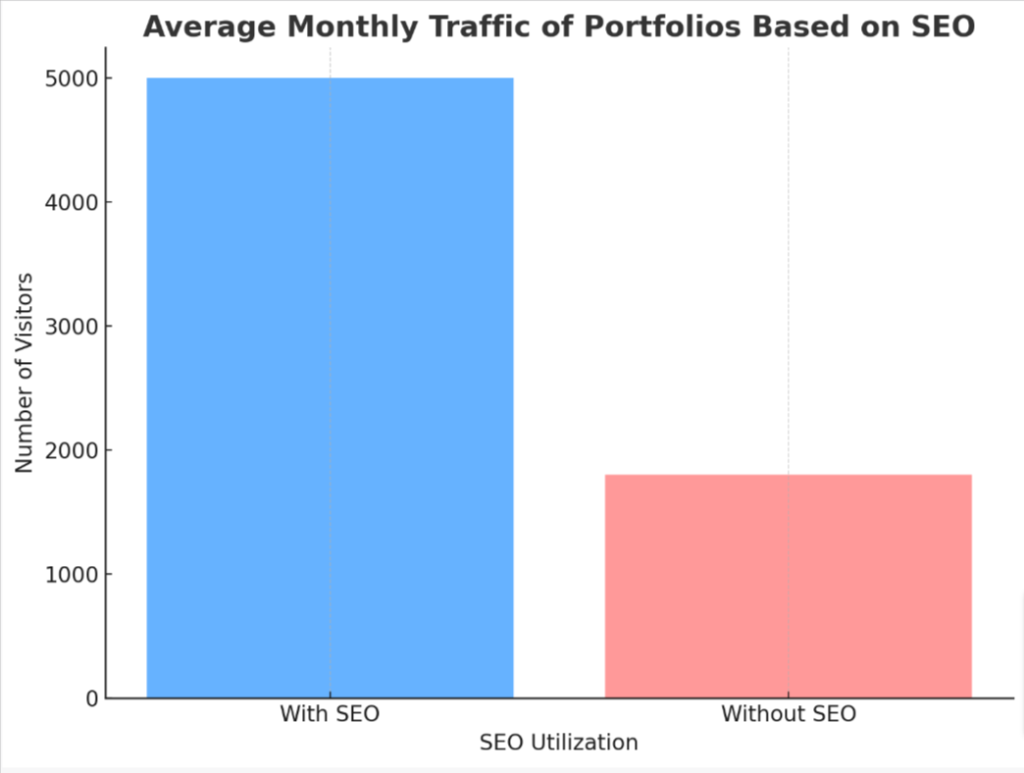Optimizing Your Writing Portfolio for Search Engines
Are you struggling to attract clients or employers to your online portfolio? It’s a common issue, but did you know that with the right SEO strategies, your work can skyrocket in visibility on major search engines.
This article is packed with actionable tips and tricks for optimizing your portfolio for better discoverability. Let’s dive into making your work impossible to overlook.
Key Takeaways
- Portfolio SEO is crucial for increasing visibility and attracting clients and employers.
- Optimizing your portfolio involves conducting keyword research, optimizing meta tags, using high – quality images, and building backlinks.
- Mobile optimization, user experience, social media integration, and tracking progress through analytics are important factors in portfolio SEO.
- Implementing these strategies can help make your work more discoverable online.
Understanding the Importance of Portfolio SEO
Portfolio SEO is crucial for increasing visibility and discoverability, attracting potential clients and employers, as well as standing out from competitors.
Increase visibility and discoverability
Increasing visibility and discoverability online is the main goal of Portfolio SEO. Making your work easily found by search engines like Google, Bing or Yahoo helps to attract potential clients in your niche.
Consider choosing a domain name that directly links to the type of work you do for better results. Create PDF documents showcasing your projects and include targeted keywords throughout your writing portfolio for organic search benefits.
An optimized portfolio not only amplifies online presence but also develops credibility and trust among target audience, elevating overall brand image.
Attract potential clients and employers
Optimizing your portfolio to attract potential clients and employers is a crucial step when it comes to enhancing visibility. Good SEO practices will ensure that your body of work surfaces in search engine results when potential clients or employers are on the lookout for services you offer.
This improves their chances of stumbling upon your online presence and accessing the impressive collection of work you have showcased.
Casting a wider net in the digital world allows more eyes on your portfolio, thus increasing opportunities for engagement. With an optimized portfolio, not only do you establish yourself as a professional in your domain but also make it easier for interested parties to reach out with proposals or projects.
This can significantly boost business prospects while simultaneously making sure you stand out amongst competitors vying for similar opportunities.
Stand out from competitors
Optimizing your portfolio for SEO helps distinguish you from the competition. In a digital world where countless portfolios are vying for attention, SEO can be the difference between getting noticed or blending into the crowd.

Utilizing search engine optimization enhances your online presence and makes your work more visible to potential clients.
Having a unique online portfolio isn’t enough on its own; you need to make it discoverable as well. Search engines like Google, Bing, and Yahoo use complex algorithms that favor well-executed SEO strategies.
As such, effective use of these strategies can significantly boost your portfolio’s position in organic search results. This heightened visibility gives you an edge over competitors who aren’t optimizing their work for searchability.
Key Strategies for Optimizing Your Portfolio for SEO
Conduct keyword research and optimization, optimize meta tags and descriptions, utilize high-quality images, and build backlinks to promote your portfolio.
Conduct keyword research and optimization
To optimize your portfolio for SEO, start by conducting keyword research and optimization. This will help you understand the terms potential clients and employers are searching for when looking for work like yours. Use tools like Google Keyword Planner or SEMrush to identify relevant keywords related to your niche.
Incorporate these keywords naturally throughout your portfolio, including in your project descriptions, titles, and headings. Make sure to choose specific, targeted keywords that accurately represent your work and align with what people are searching for.
Optimize meta tags and descriptions
Optimize your meta tags and descriptions to improve your portfolio’s SEO. This helps search engines understand the content of your portfolio and makes it more discoverable.
- Use relevant keywords in your meta tags and descriptions to increase visibility
- Craft compelling meta titles that accurately describe each page
- Write concise and informative meta descriptions that entice users to click
- Include relevant information such as your specialty or niche
- Make sure the length of your meta tags and descriptions adhere to SEO best practices
- Regularly update and optimize your meta tags and descriptions for maximum impact
Utilize high-quality images
Using high-quality images is a crucial aspect of optimizing your portfolio for SEO. When you showcase your work with visually appealing and professional-looking images, it not only grabs the attention of potential clients and employers but also improves the overall user experience.
By choosing high-resolution images that accurately represent your work, you can enhance the visibility and discoverability of your portfolio in search engine results pages. High-quality visuals help to convey credibility and professionalism, making your portfolio stand out from competitors.
Additionally, properly optimizing image file names and alt tags with relevant keywords can further boost your portfolio’s search engine rankings. So make sure to invest in high-quality images to make a lasting impression on visitors and improve the chances of getting discovered by potential clients or employers.
Build backlinks and promote your portfolio
Promote your portfolio by building backlinks and gaining exposure. Here are some strategies to help you:
- Collaborate with other professionals in your industry and exchange links.
- Guest blog on relevant websites and include links to your portfolio in the author bio.
- Reach out to influencers and ask them to mention your portfolio on their platforms.
- Take advantage of social media by sharing your work and including links back to your portfolio.
- Participate in online forums or communities where you can provide value and share your portfolio link when appropriate.
- Submit your portfolio to online directories or industry – specific websites for increased visibility.
Next-Level Tips for Portfolio SEO
Optimize your portfolio for mobile devices to ensure a seamless experience for users.
Mobile optimization
Mobile optimization is an essential aspect of portfolio SEO. With more and more people accessing the internet through their smartphones and tablets, it’s crucial to ensure that your portfolio website is mobile-friendly.
When your site is optimized for mobile devices, it will load quickly and display properly on smaller screens, providing a seamless user experience. This not only improves the overall usability of your portfolio but also boosts its visibility in search engine rankings.
By prioritizing mobile optimization, you can reach a wider audience and increase the chances of potential clients or employers discovering your work while they’re on the go.
User experience and site speed
A positive user experience and fast site speed are crucial factors for optimizing your portfolio for SEO. When visitors arrive at your portfolio website, they expect it to be easy to navigate and quick to load.
Slow-loading websites can lead to high bounce rates, meaning users leave the site before exploring further. To improve user experience, make sure your website is mobile-optimized and has a clean design.
Additionally, optimize images by compressing them without sacrificing quality. By prioritizing user experience and site speed, you enhance the overall performance of your portfolio and increase its chances of being discovered by potential clients or employers in organic search results.
Social media integration
Integrating social media into your portfolio can greatly enhance your discoverability and online presence. By connecting your social media accounts to your portfolio, you can easily share your work with a wider audience and attract potential clients or employers.
Additionally, incorporating social sharing buttons on your portfolio website allows visitors to easily promote and share your work across various platforms, further increasing its visibility.
Maximizing the power of social media integration is an effective strategy for boosting your portfolio’s SEO and generating more opportunities in the digital landscape.
Utilize analytics and track progress
Utilize analytics and track progress to improve your portfolio SEO.
- Monitor website traffic and user behavior
- Identify popular pages and content
- Track keyword performance and rankings
- Analyze bounce rates to improve engagement
- Study referral sources to optimize marketing efforts
- Use data to make informed decisions for portfolio optimization

Conclusion
In conclusion, optimizing your portfolio for SEO is crucial in making your work discoverable. By implementing strategies like conducting keyword research, optimizing meta tags, and building backlinks, you can increase visibility and attract potential clients and employers.
Don’t forget to also focus on mobile optimization, user experience, social media integration, and tracking progress through analytics to take your portfolio SEO to the next level. Start boosting your online presence today!

